#ray-finned fish
Text
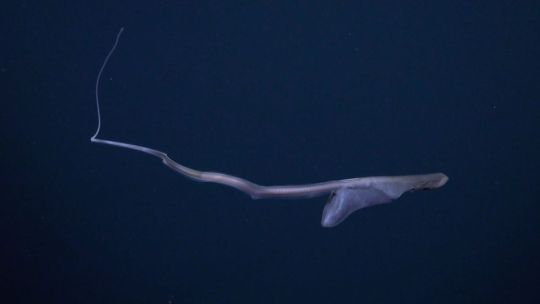
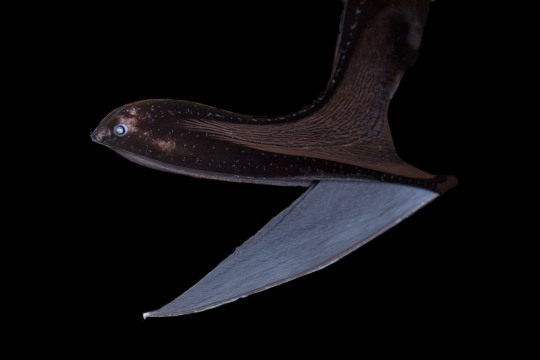
youtube
The Can-do Pelican Eel
The pelican eel, also known as the gulper eel (Eurypharynx pelecanoides), are the only known species of eel in the family Eurypharyngidae. They are found exclusively in the deeper parts of the water column, from depths of 500 up to to 3,000 m (1,600 to 9,800 ft), but are distributed throughout all the world's oceans.
The gulper eel is perhaps most famous for its unique body shape. Like many deep-sea fish, this species is highly adapted to its environment; maximum energy efficiency is the highest priority. To that end, the pelican eel has a large head, and a jaw estimated to be quarter of the total length of its body. The jaw is loosely hinged, meaning that gulper eels can open their mouths extremely wide. The rest of the eel, in contrast, is quite slender and long, about 0.75 m (2.5 ft) in length on average. Most individuals are black--so black, in fact, that they only reflect 0.5% of light; perfect for hiding from potential predators.
Although they look skinny, E. pelecanoides can expand their stomachs to hold prey much larger than themselves. Their primary prey consists of crustaceans and cephalopods, though they may feed opportunistically on other fish. Because it is so well camouflaged, it uses bioluminescent organs on the tip of its tail to attract prey. Gulper eels themselves are preyed upon by lancetfish and other larger deep-sea fish. To deter predators, they will gulp down a large amount of water; this stretches the loose skin around their head and throat, and inflates them to several times their usual size.
Because of their remote location, the breeding habits of gulper eels are relatively unknown. However, it is believed that smell plays a large part in attracting a mate, as pelican eels have highly developed olfactory organs. Like other eels, they're born as tiny, transparent larvae in a state known as the leptocephalus stage. At this stage, they do not have any red blood cells. Researchers aren't sure how long it takes gulper eels to become fully mature, or how long they live, but many believe that adults die shortly after mating.
Conservation status: The population size of E. pelecanoides has not been assessed, and thus the IUCN has not made a determination on its status. The greatest threat for this species is deep-sea trawling, which frequently brings up gulper eels as by-catch.
Photos/Video
Paul Caiger
Schmidt Ocean Institute
EV Nautilus Team (I highly recommend checking out their 2023 highlights reel!)
#pelican eel#gulper eel#Anguilliformes#Eurypharyngidae#eels#ray-finned fish#bony fish#fish#pelagic fauna#open ocean fauna#pelagic fish#deep sea#deep sea fish#Atlantic Ocean#Pacific Ocean#Indian Ocean#Arctic Ocean#Southern Ocean#animal facts#biology#zoology#ecology#marine fauna#marine fish#Youtube
122 notes
·
View notes
Text
Daily fish fact #636
Ray-finned fish!
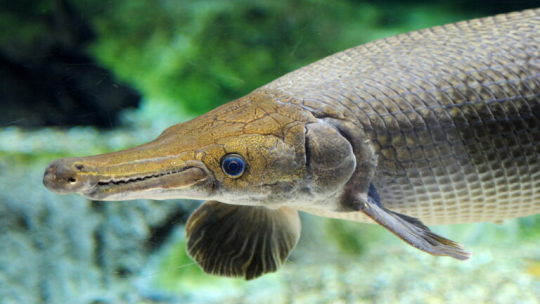
Ray-finned fishes (class Actinopterygii), also known as actinopterygians, are the most abundant group or vertebrates, as various estimates say the class is comprised of 25 000 - 32 000 species! Most are traditionally characterised by their fanlike fins, which are made of skin stretched out over bone spines. The biggest group inside of the ray-finned fishes are the teleosts, which make up about 99% of all ray-finned fish.
#i picked alligator gar as the picture because she looked polite#fish#fishfact#fish facts#fishblr#marine biology#biology#zoology#ray-finned fish
248 notes
·
View notes
Text

Had the sudden urge to do a quick digital colouring of this
#art#my art#digital art#traditional art#pencil drawings#mixed media#wildlife art#fishblr#fish#ray-finned fish#atlantic sturgeon#acipenser oxyrinchus
18 notes
·
View notes
Text

Ever overate at a buffet to get your money's worth? That's the life of a black swallower (Chiasmodon niger).
This species is extremely common in the north atlantic, however it is rarely seen due to its preferred habitat being 700–2,745m (2,297–9,006 ft) below the surface of the ocean.
Unsurprisingly, it is not often that this remarkable fish wanders into a prey species in the vast darkness of the abyss. As such the 15cm to 20cm fish has an unusual strategy to make the most of every encounter.
This fish’s flexible jaw joint allows it to swallow fish much larger than its skull and the distended stomach is an adaptation to hold these huge meals. In fact, the animal has been known to consume prey so large that it begins decomposing before the presses of digestion has fully occurred, in this event the gasses produced by the rotting carcass will cause the fish to become buoyant and float to the surface of the ocean.
#tw animal death#marine life#marine biology#marine animals#marine zoology#marine#deep sea fish#osteichthyes#oceanlife#deep ocean#ocean#ocean life#ocean animals#fish#Ray-Finned Fish
19 notes
·
View notes
Text
Lobe finned versus ray finned fish

Short answer: ray finned fish evolved from from lobe finned fish
Long answer: Lobe finned fish were dominant for a long time in the waters before they climbed up onto land and evolved into you, dear reader. This occurred around 400 MYA (million years ago). Sometime before that, about 425 MYA, ray finned fishes had evolved, but remained relatively small. This was until the permian mass extinction (290-245 MYA), when many lobe finned fish died out, and ray finned fishes (teleosts) were left to flourish and evolve to fill the empty evolutionary niches. The only lobe finned fish left behind today are the elusive coelacanths and lungfish. ***AND*** as the awesome people in the notes would like me to add, all tetrapods (tetra meaning four, pod meaning foot) are phylogenetically lobe finned fishes as well. this means amphibians, reptiles, and mammals.
@marinebiologyshitposts @fuckyeahcoelacanths
#marine biology#lobe finned fish#ray finned fish#coelacanth#evolution#science#things ya should know#zoology#biology#ecology#animal facts#animals
1K notes
·
View notes
Text
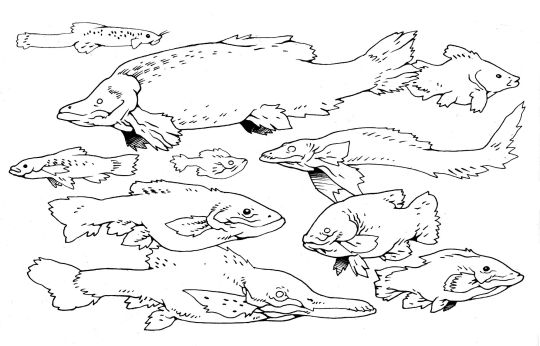
Ray-Finned Fishes
465 notes
·
View notes
Text
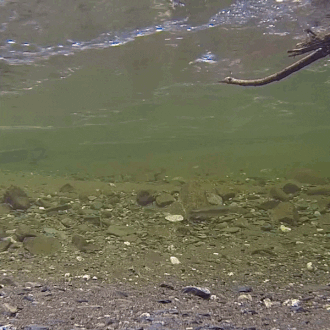
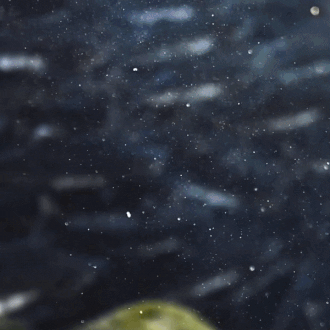
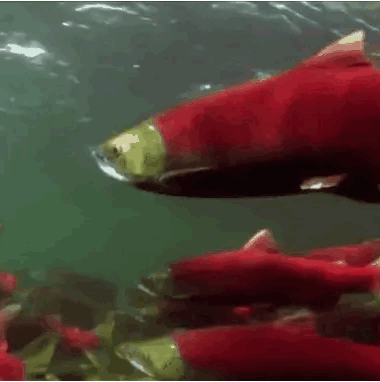
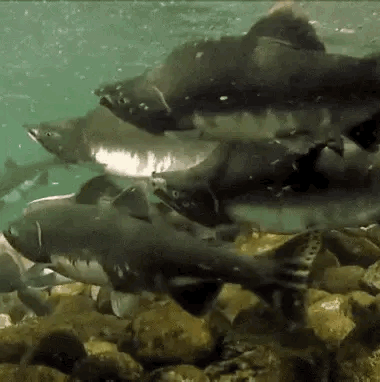
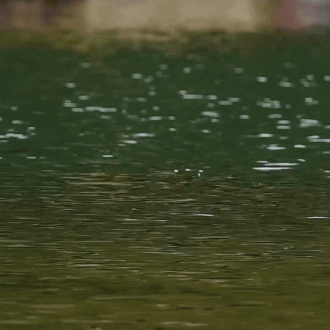
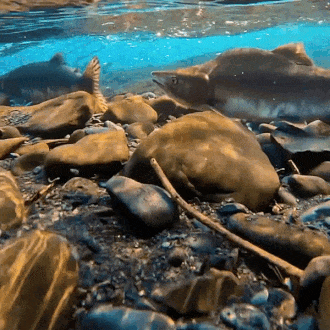
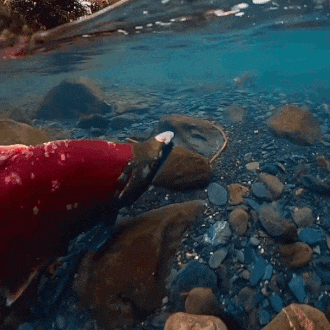
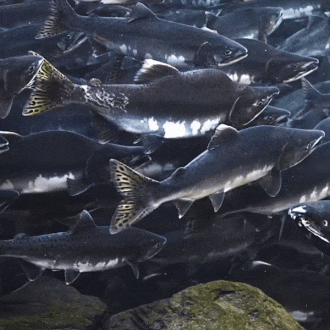
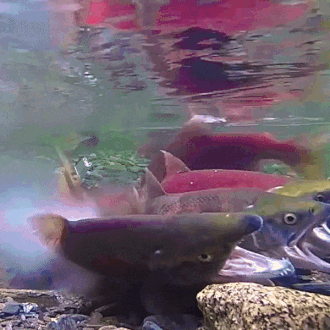
salmon for anon!
🐟-🌊-🐟 / 🌊-🐟-🌊 / 🐟-🌊-🐟
#stim#stimboard#salmon#fish#sfw#nature#red#gray#grey#blue#green#underwater#animals#water#sockeye salmon#freshwater fish#salmon run#rocks#euryhaline ray-finned fish#rivers#requests
900 notes
·
View notes
Note
coelacanth, what are your thoughts on Actinopterygii?

547 notes
·
View notes
Text
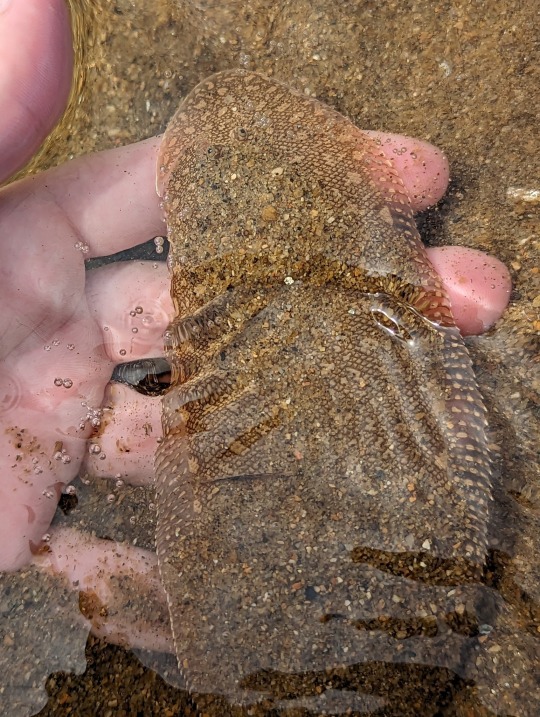


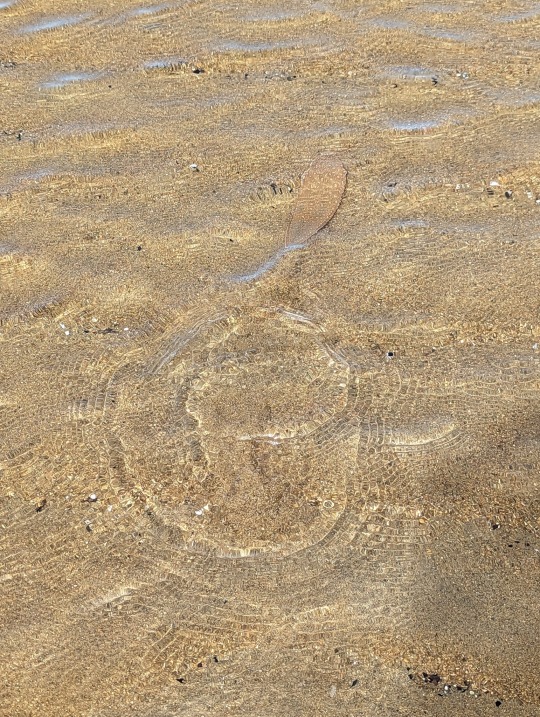
Flatfish found at low tide. Very well hidden, I only found it after I had accidentally stepped on the poor thing.
13/08/23 - Pleuronectoidei sp.
QLD:WET - Flying Fish Point, low tide sandy bay
#Pleuronectoidei#Flatfishes#Carangiformes#Actinopterygii#Ray-finned Fishes#Vertebrata#Vertebrates#Chordata#Chordates#fish#fishblr
52 notes
·
View notes
Text







Esra\ Pancake!! expert gremlin gamer
She rents room from banan eel guy her money comes from grinding skins for other ppl in mmo. When it isn't grinding \still grinds on the phone\ she goes out to eat AND EAT A LOT OH BOY. Nearest non lactose caffe owners scared shitlles of friday evening cuz she eats thru entirety of they stock \sometimes tags trench along thats @milkaide fish dude\
#oc#ray#manta ray#anthro#my art#art#esra#huge sweets enjoyer#her fin arms prett stronk#goofy silly gremlin I love heeer#fish
143 notes
·
View notes
Text

first fish of the new year :)
#fish#gouache#painting#art#artists on tumblr#illustration#fish illustration#icthyology#mine#she sells sea shells by the sea shore#sea#ocean#marine#ray finned fish#flying fish#angelfish#mahi mahi#lionfish#mola mola#sunfish#clownfish#nemo#surgeonfish#dory#conger eel#eel#seaweed#sea shells#sea creatures
87 notes
·
View notes
Text
Uncharismatic Fact of the Day
These fish is the GOAT-- the goatfish, that is! The species in this family are characterized by the two long barbels which extend from their chins like a goatee. The barbels act like whiskers, and contain chemosensory organs which help the goatfish to probe the ocean floor for a potential meal.

(Image: A blue-striped goatfish (Upeneichthys lineatus) by John Turnbull)
If you like what I do, consider leaving a tip or buying me a kofi!
184 notes
·
View notes
Text
What Is and Isn't a Fish: an Essay and Guide by Fishyfishyfishtimes
A simplified list of the animals I discuss can be found here!
Hello folks! I created this post to have a kind of definitive essay/explanation of what is and isn't a "fish", starting with defining the term and going over animals that fit and don't fit the bill. As other fishblr artists, writers and educators must know too well, some people are confused about where this term begins and ends, mistaking other aquatic animals for fish. I have my fair share of arthropods and cnidarians as fish fact requests in my own askbox, heck, some years back a friend of mine asked me if clams were fish. The event that finally made me decide to write this was someone requesting that a fish-only account draw a crustacean, pondering to themselves if they count as fish.
I don't want to hold it against these people. It's impossible to know something when you've never been taught! So that's what I'm here to do, hopefully achieving a pretty correct and universal view ^^' If I make any mistakes please correct me. I'm learning all the same as everyone else is.
Definition of fish
Immediately, we run into a bit of a problem with the definition of fish. See, what the term "fish" means has fluctuated for centuries! For a long time, pretty much any animal that lived in water was a "fish" — I say "pretty much any" instead of "every" animal because for a long time sessile animals like sponges or corals were thought to be plants. This is why we have such remnants in our language like shellFISH, starFISH and jellyFISH, they lived in water so they were called such!
Occasionally these definitions would be changed for cultural convenience too. Many Christian churches take part in Lent, and in the Catholic church red and white meat is forbidden on Fridays and Ash Wednesday. In the Middle Ages, in my own country, Finland, this abstinence of red and white meat could last up to 140 days! To make fasting easier, many animals were labelled fish for convenience so they could be eaten as well. These newfound "fish" included seals, beavers and swans, pretty much just anything that was aquatic or semiaquatic in nature.
Nowadays just going off of looks or behaviour won't do, though. There has been much more of an effort to define fishes coherently based on their anatomy and phylogeny, which is great! Problem is, that's easier said than done: fishes are an extremely diverse group, and uh.. not really a single group, either. I'll show you:

As you can see from this heavily simplified phylogenic tree, fishes are not a singular group like, say, mammals are! The animals that we group under "fish" are actually a part of several distinct lineages of animals, some more closely related to us than each other. Heck, tetrapods, which include amphibians, reptiles*, and mammals, are fish themselves! Phylogenetically speaking. Our ancestors were lobe-finned fish, and, well, you never stop being the previous taxon even when you evolve into something else. If you try to exclude tetrapods, no such unified group as "fish" exists. Still, when discussing fish, we tend to want to avoid talking about every vertebrate ever and instead focus on the very specific aquatic ones we mean when we say "fish". This is why many definitions of the term "fish" still exclude tetrapods, even if we share a common fishy ancestor. "Fish" describes more of a lifeform than it does a clade, much like the term "worm"!
(*birds are reptiles! This could be a whole post in and of itself, but I'm not here to write about that. Someone else has most likely taken up the task!)
Hooray, it's definition time! As stated previously, fishes are an extremely diverse group of thousands of species, and what terms might apply to the Atlantic cod may not apply to the yellowfin tuna or giant mudskipper, let alone a Pacific lamprey! Encyclopedia.com defines a fish as "an ectothermic chordate that lives primarily in water and possesses a cranium*, gills that are useful virtually throughout life, and appendages (if present) in the form of fins". Encyclopedia Britannica notes that "the term fish is applied to a variety of vertebrates of several evolutionary lines", instead highlighting five classes. These five classes are left partly unspecified, but ones that are mentioned are jawless fish, cartilaginous fish and bony fish (which still includes tetrapods, however), and the two classes left can be assumed to be two classes of extinct fish. Wikipedia defines a fish as "an aquatic, craniate**, gill-bearing animal that lacks limbs with digits". Tim M. Berra, an academy professor and ichtyologist, defines fish as "poikilothermic***, aquatic chordate with appendages (when present) developed as fins, whose chief respiratory organs are gills and whose body is usually covered with scales".
(*cranium=upper part of the skull **craniate=an animal with a skull ***poikilothermic=an animal whose internal temperature varies considerably)
From these more or less detailed definitions we can gather many defining features for fish: a cranium-having chordate, primarily aquatic, gill-bearing and uses gills as their main respiratory organ, lacking any limbs with digits, instead having their limbs be in paired and unpaired fins when present. Most fish are also ectothermic, meaning their body temperature is determined by their environment, but some can heat up parts of their body or their entire body in the case of the opah. Most fish also have scales, but not all, just like how most fish are fully aquatic, but some like lungfish or mudskippers can spend considerable time out of the water. Such is the way of these magnificent and diverse animals!
Finally, with all this out of the way, we can get into...
What is a fish!
Here, I will be detailing animals that are fish! Well, at least the broadest strokes; there are more than 30 000 fish species and if I listed them all we'd be here all life. I shall instead go over the major classes and list, in short, some groups that belong in them.
Jawless fish (Superclass Cyclostomi)
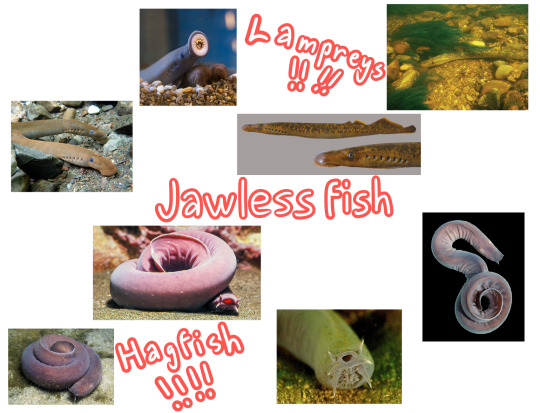
Jawless fish are often a topic of debate, especially in matters of their relation to each other and to jawed vertebrates. Evidence seems to point to hagfish and lampreys being closest related to one another and to lampreys being more closely related to jawed vertebrates than to hagfish (which would make hagfish craniates but not vertebrates). In the phylogeny tree above I decided to portray hagfish and lampreys as a monophyletic group, as molecular studies and microRNA analysis seems to point to a monophylegic superclass. Please note that this could go either way, though.
Jawless fish is a group containing two extant fishes, hagfish (class Myxini) and lampreys (order Petromyzontiformes)! Jawless fish are more "primitive" than other groups, for example both lack true vertebrae and scales. Still, they both have craniums and gills and they are aquatic, and so they have earned their place among fish!
Cartilaginous fish (class Chondrichthyes)
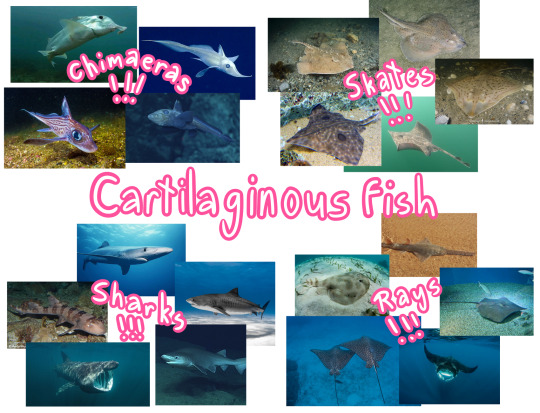
Surprisingly, I've found that this group has a lot of confusion surrounding it. I have received many a request confirming if sharks are fish, or asking if I'd cover a shark "even if it's not a fish". So I'll say it now: good news, sharks are indeed fish! So are their cousins, rays, skates and chimaeras, also known as ghost sharks! All of these fish have a primarily cartilaginous skeleton, tooth-like dermal denticles and lack gill covers and a swim bladder. Out of all the sharks, I also want to highlight that the whale shark, despite its confusing name, is a shark and not a whale. So, it is a fish!
Ray-finned fish (class Actinopterygii)
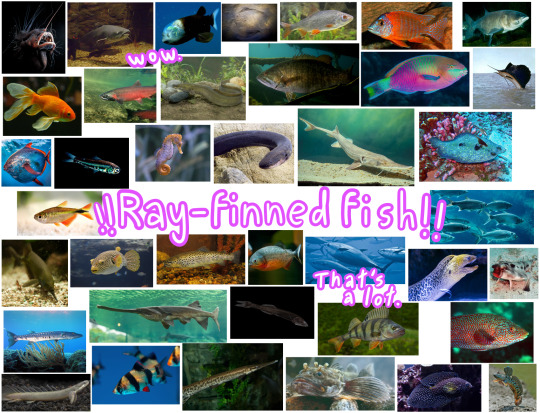
Name any fish, and there's a 96% chance the species name you said belongs to a ray-finned fish. Unless, like, you really like sharks. But this isn't about them.
Ray-finned fish are the biggest group of fish and incredibly diverse! It has your seahorse, your pufferfish, your bass, your tuna, your anglerfish, your clownfish, your salmon, your sturgeon, your lanternfish, your perch, your oarfish, your gar, your sardine, your moray eel... and this is only a tiny, tiny fraction of the groups that belong to this class! Defining features of ray-finned fish are that they tend to have a swim bladder and a bony skeleton (some exceptions though. Sturgeons, for one, have evolved a cartilaginous skeleton but they're still ray-finned fish). The largest group of ray-fins, the teleosts, also have leptoid scales, which are thinner and more flexible and grow with growth rings.
I want to bring special attention to some members of the ray-finned fish which tend to have a lot of confusion surrounding them and their heritage: eels and seahorses. Many people think these two are not fish due to their strange anatomy, like lack of scales or (many) fins and their elongated bodies, and I wouldn't blame them! Seahorses belong to family Syngnathidae, which also includes seadragons and pipefish. Eels, meanwhile, make up the order Anguilliformes. All of these long friends of ours are fish!
Lobe-finned fish (clade Sarcopterygii)

I shall merely focus on the fishy fishy fish individuals of this class, which excludes tetrapods. Lobe-finned fish house the two extant species of coelacanths, and six extant species of lungfish! These fish are bony and their fins are placed at the tips of fleshy, lobelike stalks, resembling the limbs of tetrapods. It is thought that the common ancestor of coelacanths and lungfish and tetrapods had similar structures that then became the four limbs the members of our clade typically have. Coelacanths and lungfish are wonderful fishes and deserve a lot of love and respect, not only because they're our closest cousins but because they're unique and we have so much to learn about them!
So, these are the fishes! There are also extinct groups of fish, namely class Placodermi (armoured fish) and class Acanthodii (spiny "sharks"). I'm moreso an extant fish account however, and so I shall move onto...
What isn't a fish?
Now we get into the real meat of this post. Without further ado, here are some aquatic friends of ours that can be mixed up with fish very often!
Crustaceans (subphylum Crustacea)
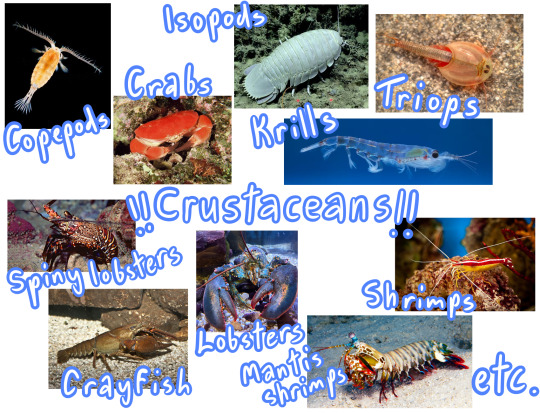
Many of our hard-shelled many-legged friends belong here! Crabs, lobsters, crayfish, shrimp, krill, isopods, triops, barnacles, copepods, you name it! Even though many crustaceans are aquatic or semiaquatic and have gills, you'll find that they're invertebrates that lack an internal skeleton (so no cranium, not even vertebrae)! We still love them though!
Mollusks (phylum Mollusca)

Creatures both soft and hard-shelled! Cephalopods like octopuses, squid, nautilus and cuttlefish, bivalves like clams, mussels, oysters or scallops, gastropods like sea slugs and snails and chitons go here! These friends of ours are also aquatic and have gills, some even have the suffix -fish (cephalopods used to be called inkfish, even!), but their lack of an endoskeleton is even more obvious than the crustaceans'. They're invertebrates, and therefore not fish!
Chelicerates (subphylum Chelicerata)
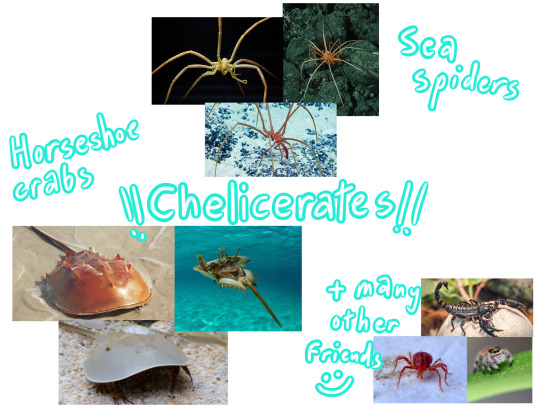
This group has many animals that are very hard to mistake for fish, namely spiders and scorpions, but horseshoe crabs and sea spiders are two groups of extant marine chelicerates! Both groups are aquatic, and horseshoe crabs have gills. However, they're both invertebrates, lacking a cranium or vertebrae. Other aquatic chelicerates exist, but they're usually very small, like water mites.
Cnidarians (phylum Cnidaria)

This phylum has the sessile corals and sea anemones and the usually more mobile jellyfish and siphonophores (includes the infamous Portugese man o' war!). I imagine corals and sea anemones are mistaken for fish less due to their sessile nature, but they're good to bring up nevertheless. None of these animals have a backbone, or, any bones really. They lack gills, they lack fins, they even lack the bilateral shape of fish. Jellyfish, despite the name, are indeed not fish! Some people suggest the name sea jellies be used for them instead, and I think it's much cuter.
Echinoderms (phylum Echinodermata)

Animals like starfish, sea urchins, brittle stars, sand dollars, sea cucumbers and feather stars go here. It seems that this pesky "-fish" -suffix is hard to shake off, as now we have the starfish. Once again, all of these slow-moving bottom-dwelling friends of ours are invertebrates, as they lack vertebrae or a cranium. Interestingly though, they are among our closest invertebrate relatives! So we ought to give them some props for that. I also want to mention that starfish can also be called sea stars, which ought to lessen confusion about their being too.
Comb jellies (phylum Ctenophora)

Comb jellies look a lot like jellyfish, but they belong in their own unique phylum! They have the same deal going on; they are invertebrates, they lack gills, they lack a cranium, they are simply aquatic.
Lancelets (subphylum Cephalocordata) and tunicates (subphylum Tunicata)
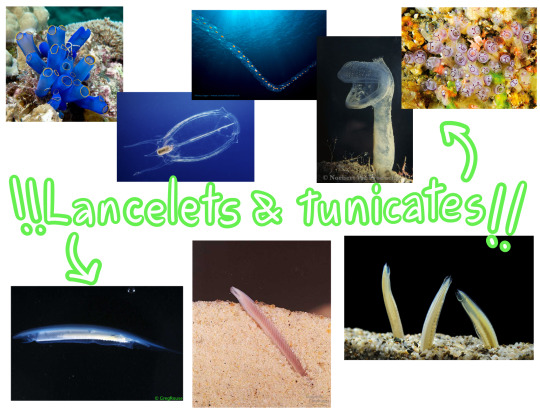
A double feature, because I wanted to save space didn't want these guys to be all alone! Lancelets and Tunicates, like sea squirts and salps, are chordates, which you can find in the phylogenic tree I drew all the way in the definitions section. They share many a feature with vertebrates, like a bilateral bodyplan, a notochord at some stage of life and a post-anal tail, but I'm afraid they're still not fish. They lack a cranium and their notochord does not develop into a vertebral column! Sorry friends, you tried. We can still hang out at the chordate convention.
Annelids (phylum Annelida)

The infamous bobbit worm, bone-eating worms, sea mice, giant tube worms, feather duster worms, spoon worms, bristleworms in general, leeches... many, many worms go here! Pretty self-explanatory: they are invertebrates, even when they live in water. They're extremely cool invertebrates too! I suggest taking a look at some of them, there's many interesting species.
Flatworms (phylum Platyhelminthes)

Flatworms are another very diverse group of worms, having many species both terrestrial and aquatic, however mostly I want to put attention into the free-swimming marine flatworms. They may swim beautifully (and fence with grace), but they are nevertheless invertebrates! Flatworms can live a variety of different lifestyles, from predators to parasites.
Amphibians (class Amphibia)

We've made it into vertebrates now! Amphibians include frogs, salamanders, and caecilians. While they have limbs with digits in their adulthood*, they can be easily confused for fish in their larval stages! This is no surprise, as they use gills to breathe underwater and tadpoles lack any limbs at all for a while. Many amphibians later transition into a terrestrial or semiaquatic way of life and lose their gills, not to mention gain their digit-having limbs.
(*excluding caecilians)
...Well, many amphibians do this, but not all. It's important to mention there are also species of aquatic salamanders which can bear great resemblance to fish with their elongated bodies! Amphiumas, which are sometimes mistakenly called "conger eels" (which is an actual species of fish), are aquatic salamanders with small residual limbs and both working gills and lungs. Giant salamanders and mudpuppies/waterdogs have lungs and gills as well, and lead an aquatic lifestyle — olms are close relatives of mudpuppies. Sirens, meanwhile, lack hind limbs and only have small front limbs, along with retaining their gills in adulthood. Among aquatic salamanders I also want to bring up one most often talked about species: the axolotl! They remain in their larval form, have external gills and lead an aquatic lifestyle. It can be hard to tell with aquatic salamanders sometimes, but these friends of ours are amphibians and not fish, even if they've rejected the land life.
Caecilians are a bit less known overall, but they can also cause a lot of confusion due to their long, limbless body. While most caecilians live underground, some are aquatic in nature, and can therefore be mistaken for fish! However, caecilians breathe via the use of their lungs and through the skin and don't have any gills at all.
Reptiles (class Reptilia)

Most commonly mistaken for fish in this group are sea snakes, sea kraits and water snakes, sea turtles, turtles, penguins, and other (semi)aquatic birds. Sea snakes and water snakes bear a very strong resemblance to eels, but they are indeed just snakes adapted to an aquatic or a semiaquatic lifestyle! The same goes for sea turtles, turtles overall, and penguins. They all need to breathe air and they lack fins, even if their flippers, webbed feet and built-in paddles may look like fins! They also have wholly different types of scales (or feathers!!) than what fish have, even if they share the feature. I assume that other aquatic reptiles, like the marine iguana and crocodilians are better read as reptiles thanks to their limbs with digits, but I want to give them a reptile shoutout anyway. They’re aquatic or semiaquatic, but they are air-breathers and fin-lackers all the same!
I also want to mention one specific extinct group of reptiles, ichtyosaurs! These marine reptiles were rather shark- or dolphin-like in appearance, which is actually a really good example of convergent evolution! Like all other reptiles, they also needed to breathe air and they had... erm... well, I'm not sure if I can call the bones in their flippers digits, but, that's what they used to be, so...? They were cool reptiles and among my favourites! There were many other aquatic reptiles too, but I will only mention just the ones now. A paleontology account would be better-suited to list you allll the marine reptiles.
Mammals (class Mammalia)

Our home class! Some of the aquatic friends we have in this class include whales like baleen and beaked whales, dolphins (orcas go here), porpoises, belugas, narwhals and sperm whales, pinnipeds like seals, sea lions, walruses, and sirenians like manatees, (occasionally known as sea cows) and dugongs! We also have some semiaquatic buddies like hippopotamids, otters, beavers and platypuses! Whales and pinnipeds especially often cause a lot of confusion due to their very streamlined, fishy appearance. They are, however, air breathers that feed their young with milk (some dolphin calves are even born with some hair), and their ancestors were land mammals! The same goes for pinnipeds and sirenians too. True seals, fur seals and sea lions still have fur even! Hippos, otters, beavers and platypuses are a bit more obvious as mammals with their fur and.. distinct air-breathing.. but I wanted to mention them anyway. Their adaptations to aquatic life are just one example of how fascinating evolution can be!
And here we are! A hopefully comprehensive list of fishes and non-fishes, beginning with the ever-shifting story of the term "fish", phylogeny, and why some animals are called fish when they really aren't. I hope you have found useful and interesting information in this post, and perhaps learned something new! I bid you a farewell! :D
#fish guide#fish essay#fish#fish facts#fishfact#marine biology#biology#zoology#long post#jawless fish#cartilaginous fish#ray-finned fish#lobe-finned fish
255 notes
·
View notes
Text

A little graphite sketch of an Atlantic sturgeon, thanks to @aquar-io for the suggestion!
Even though there are definitely anatomical mistakes/other wonky things present in this drawing I'm actually feeling quite proud of this sketch. I've been feeling that way about a lot of my art for the past few days- even though I've made mistakes the art I do is still good because I made it. I made it with my own two hands and my own passion for the craft. I will inevitably improve and those mistakes are proof of that.
#art#my art#traditional art#pencil drawings#graphite drawings#sketches#wildlife art#fishblr#fish#ray-finned fish#actinopterygians#sturgeons#atlantic sturgeon#acipenser oxyrinchus#queue
18 notes
·
View notes
Text

Anyone who has experienced burnout (I know it's all of you, lets not forget what site we are using) may find this fact a little reassuring.
The vast majority of fish are poikilothermic, meaning that their body temperature is determined by the surrounding environment. The Bluefin tuna (Thunnus thynnus) however, is considered to be regionally warm-blooded, or somewhere in between the two extremes. This predator is able to use muscle movement to generate heat and transport this heat in their blood to some regions of the body, in a sort of basal ectothermy.
This is a very helpful adaptation for the roughly 1.5m terror, the ability to stay close to optimal temperature for energy production combined with a smooth, teardrop shaped body built to reduce drag makes this fish fast, agile and formidable.
Unfortunately for our friend here, the extreme power of their swimming muscles comes at a cost. Tuna can accelerate around 30 mph in a ten second burst, built for ambush and not prolonged speed. When stressed, the fish can push their body to the limit and reach such quick acceleration that the heat produced by the sudden muscle use can cook the tuna inside-out in an event fishers call 'burning'.
#wet beast wednesday#marine ecosystem#marine#marine animals#marine biology#marine life#fish#fishing#cordata#Ray-finned fish#sea animals#sea life#sea creature#sea creatures#marine zoology#ocean animals#oceanlife#ocean life#ocean
17 notes
·
View notes
Text
cant upset conservatives with a transition timeline as i've yet to transition but i've got the next best thing: evolutionary timeline
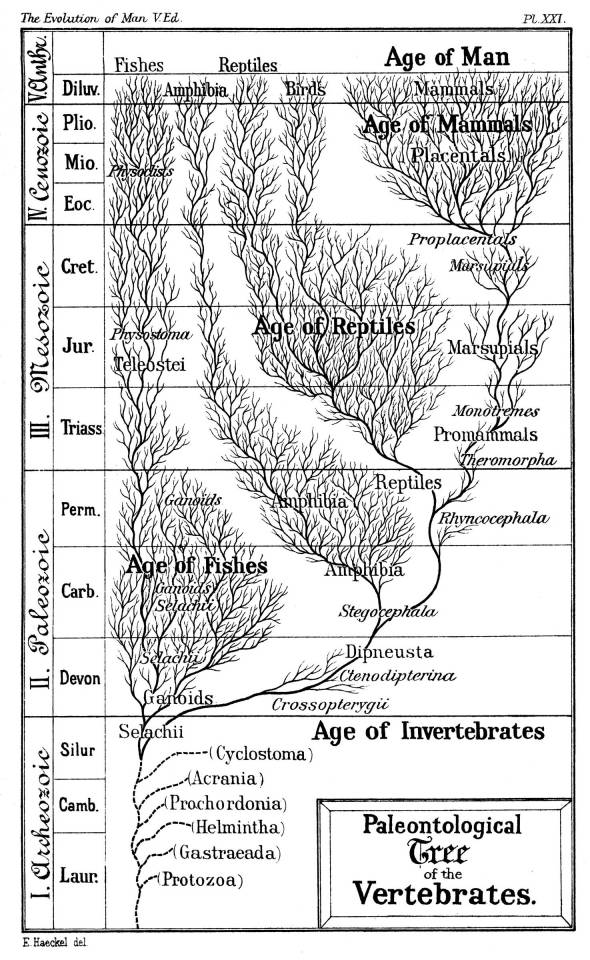
#quick question why is the fish tree so narrow?#according to wiki there are about 6400 species of mammals#and just counting ray finned fish there are 32000!#wiki says over 38k tetrapods in whole (this includes all of us that came “from” fish but we're still fish of course)#(by that i mean everything you see above. mammals amphibians reptiles which includes birds)#over 50% of vertebrates are ray finned fish so that should be like half the top part of the image#1879 so kinda out of date LMAO
3 notes
·
View notes